Dive Brief:
- The “Celluloid Ceiling” report released Jan. 3 reveals that although the number of women working behind the camera reached a historic high in 2019, men continue to outnumber women 4-to-1 in key behind-the-scenes roles.
- Women comprised 20% of all directors, writers, producers, executive producers, editors, and cinematographers working on the top 100 films of 2019. This represents an increase of 4 percentage points from 16% in 2018, according to the annual report by the San Diego State University’s Center for the Study of Women in Television and Film.
- Women made up 14% of directors working on the top 500 films, down 1 percentage point from 15% in 2018. Women film directors are more likely to hire women in lead roles than are films directed exclusively by men. Of the 500 highest-earning films last year, 59% of those directed by women hired female writers, while 13% of the writers hired to work on films with male directors were women. The annual study that has tracked women’s employment on the highest earning films for 22 years.
Dive Insight:
Opportunities for women and people of color who haven’t traditionally had access to top jobs in filmmaking still need vast improvement, say experts. And film is far from the only industry to have this problem.
In attempt to create greater diversity and inclusion in Hollywood, in front of and behind the camera, technology and media companies such as AT&T have invested in several diversity and inclusion initiatives and mentorship programs.
In 2015, backlash and protests took place over the Academy of Motion Picture Arts and Sciences’ lack of diverse Oscar nominees. The following year, the Academy approved a series of substantive changes designed to make the voting membership more diverse.
Although 98% of companies have a diversity and inclusion program, the slow pace in reaching set goals stems from major decision makers, according to a 2019 Boston Consulting Group (BCG) report, Fixing the Flawed Approach to Diversity.
The report found that a quarter of workers in diverse groups surveyed aren’t confirming any benefits from these programs. Researchers also identified men, age 45 or older who are usually the major decision-makers in companies, as one main obstacle to diversity progress.
BCG determined that diversity initiatives that have strong leadership commitment and rigorously track key performance indicators, are the most successful.
Nina Cofer, product marketing manager at Breezy HR, told HR Dive in November 2019 that D&I leaders need to provide data on diversity and inclusion to leadership to highlight its value.
“Once it is implemented,” Cofer said, “keeping leadership accountable for set metrics is a must. Diversity and inclusion is not just an HR thing, it is a company thing. Everyone in the company should be kept aware of hiring goals related to D&I.”
In regard to leadership in the film industry, women directors comprised 10.6% of the 113 directors of the 100 top movies in 2019, an increase from 4.5% in 2018, according to a study released by the Annenberg Inclusion Initiative at the University of Southern California Jan. 2.
Though this is an improvement, researchers stated that “it was still a far cry from girls and women comprising 51% of the U.S. population.” The study also indicated that “percentage of films with an underrepresented director attached was far below U.S.Census.”
Source Article: https://www.hrdive.com/news/women-make-gains-in-top-film-jobs-but-hollywood-is-far-from-gender-parity/570156/
